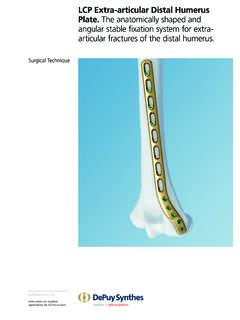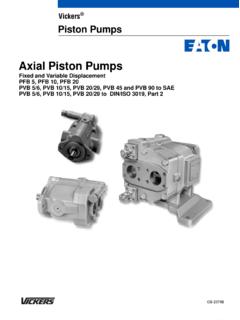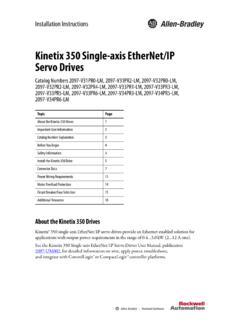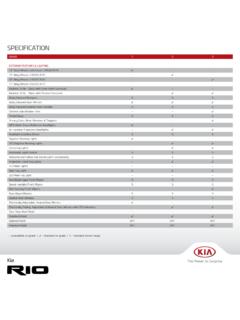Transcription of Dynamics of Power Systems - Los Alamos National Laboratory
1 Dynamics of Power SystemsIan A. HiskensVennema Professor of EngineeringProfessor, Electrical Engineering and Computer ScienceGrid Science Winter SchoolSanta FeJanuary, 2019 Outline Fundamentals of Power system angle and voltage stability. Impact of loads on Power system Dynamics . Generator controls. Modeling. Trajectory sensitivity and machines Conventional generators are synchronous machines. Rotor spins at synchronous speed. Field winding on the rotor, stator windings deliver electrical Power to the grid. Note that the dynamic behavior of wind generators (as seen from the grid) is dominated by control loops not the physics of the dynamic models Dynamic models are well documented.
2 Electrical relationships are commonly modeled by a set of four differential equations. Mechanical Dynamics are modeled by the second-order differential equation:where: angle (rad) of the rotor with respect to a stationaryreference.: moment of inertia.: mechanical torque from the turbine.: electrical torque on the Dynamics Through various approximations, the dynamic behavior of a synchronous machine can be written as the swing equation:where: deviation in angular velocity (frequency)from nominal.: inertia.: damping, this is a fictitious term that may be added to represent a variety of damping sources, including control loops and loads. (It is zero in detailed modeling.)
3 : mechanical and electrical frequency Dynamics Response of frequency following generation machine infinite bus system For a single machine infinite bus system , the swing equation becomes:where . Dynamics are similar to a nonlinear pendulum. Equilibrium conditions, and .7/40 Region of attraction The equilibrium equation has two solutions, and where:: stable equilibrium point.: unstable equilibrium point. Local stability properties are given by the eigenvalues of the linearized system at each equilibrium of attraction As increases, the separation between equilibria diminishes. The region of attraction decreases as the loading increases.
4 Solutions coalesce when . A bifurcation damping Damping reduces as equilibria move closer. In this case the system is progressive weakened by lines equilibria Real Power Systems typically have many disturbance behavior A fault on the system , for example a lightning strike, will force the states away from the stable operating (equilibrium) point. If the fault is sufficiently large, the disturbance will cause the trajectory to cross the boundary of the region of attraction, and stability will be clearing Critical clearing refers to the (hypothetical) situation where the fault is removed when the state lies exactly on the stability boundary. Conceptually, the resulting trajectory would run exactly to the unstable equilibrium point and stay there.
5 This is equivalent to bumping a pendulum so that it reaches equilibrium in the upright critical clearing Approximate a trajectory on the stability boundary by a trajectory that spends a long time near the unstable equilibrium RegionUnstable RegionParameter trade-offFault cleared14/40 Voltage reduction The single machine infinite bus example assumes the generator maintains a constant terminal voltage. The reactive Power required to support the voltage is limited. Upon encountering this limit, the over-excitation limiter will act to reduce the terminal of load Consider the effect of load behavior on stability. Two cases: Constant admittance: Constant Power : Notice the loss of structural stability as the voltage index changes.
6 Power electronic loads behave like constant Power . Bad for grid stability. Examples: energy-efficient lighting, plug-in EVs. Below a certain voltage, Power electronics shut down. This gives a fast transition from full Power to collapse Voltage collapse occurs when load-end Dynamics attempt to restore Power consumption beyond the capability of the supply system . Power Systems have a finite supply capability. For this example, two solutions exist for viable loads. Solutions coalesce at the load bifurcation point. Known as the point of maximum restoration Dynamics Transformers are frequently used to regulate load-bus voltages. Sequence of events: Line trips out, raising the network impedance.
7 Load-bus voltage drops, so transformer increases its tap ratio to try to restore the voltage. Load is voltage dependent, so the initial voltage increase causes the load to increase. The increasing load draws more current across the network, causing the voltage to drop restoration dynamics19/40 Voltage-angle interactions Each time the transformer taps up to lift the voltage at the load bus, the transmission system is weakened a little more, until the generator loses model Motivated by a desire to capture phenomena such as fault induced delayed voltage recovery (FIDVR). WECC load model:21/40 Generator voltage control Voltage control is achieved by the automatic voltage regulator (AVR).
8 Terminal voltage is measured and compared with a setpoint. The voltage error is driven to zero by adjusting the field voltage. An increase in the field voltage will result in an increase in the terminal voltage and in the reactive Power produced by the generator. If field voltage becomes excessive, an over-excitation limiter will operate to reduce the field current. The terminal voltage will subsequently system stabilizers High-gain voltage control can destabilize angle Dynamics . To compensate, many generators have a Power system stabilizer (PSS) to improve AVR instabilityBifurcation diagram as AVR gain limit cycles for .24/40 Governor Active Power regulation is achieved by a governor.
9 If frequency is less than desired, increase mechanical torque . Decrease mechanical torque if frequency is high. For a steam plant, torque is controlled by adjusting the steam value, for a hydro unit control vanes regulate the flow of water delivered by the penstock. Frequency is a common signal seen by all generators. If all generators tried to regulate frequency to its nominal setpoint, hunting would result. This is overcome through the use of a droop generation control (AGC) Based on a control area concept (now called a balancing authority.) Each balancing authority generates an area control error (ACE) signal,where is the frequency bias factor. The ACE signal is used by AGC to adjust governor setpointsat participating generators.
10 This restores frequency and tie-line flows to their scheduled values. Economic dispatch operates on a slower timescale to re-establish the most economic generation continuous-discrete interactions Note the PI block with non-windup limits. The behavior of such a block is not well defined. IEEE Standard provides a definition for such a block. Type-3 wind turbine converter control model:27/40PI block with non-windup limits According to the IEEE standard: is modeled by: This model is prone to deadlock. Most commercial simulation programs don t recognize model for type-3 wind turbines29/40 Trajectory sensitivities Consider a trajectory (or flow) generated by simulation.




